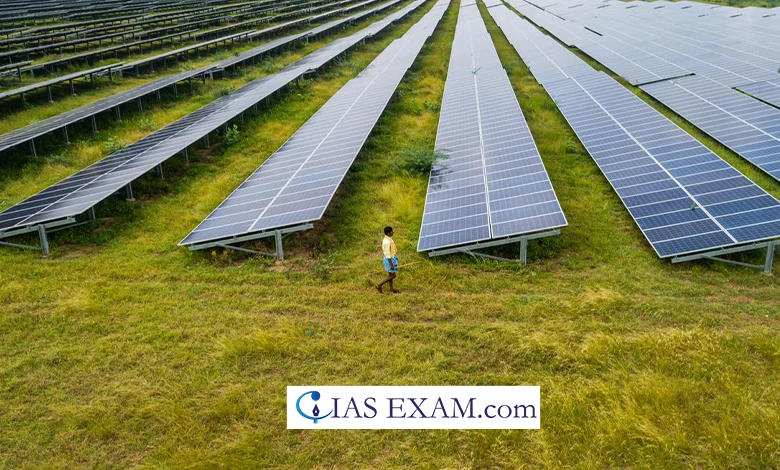
Recent News
In March 2024, the Ministry of New and Renewable Energy (MNRE) decided to reinstate its 2021 notification of an ‘Approved List of Models and Manufacturers of Solar Photovoltaic (PV) Modules’, also known as the ALMM list. This order aims to promote the use of locally sourced solar modules in India’s renewable energy manufacturing sector. However, many view it as a form of import restrictions on solar PV cells.
Details
- The import restrictions on solar PV cells are not aimed at restricting imports but are designed to boost local solar manufacturing capabilities to meet India’s renewable energy goals.
- Impact on Project Developers: Project developers have raised concerns that the import restrictions could lead to an immediate increase in solar panel costs by 6-8 percent. They also worry about potential monopolistic pricing by domestic manufacturers.
- Government’s Stance: The government’s orders aim to increase local sourcing of solar modules to support India’s renewables manufacturing ecosystem. This follows the re-implementation of the ALMM list, which was previously kept in abeyance for two years
- India’s Solar PV Import Dependency: India is heavily dependent on imports to meet its demand for solar cells and modules, with China and Vietnam being the major suppliers. The government has taken steps like the Production Linked Incentive (PLI) scheme to boost domestic production and reduce this dependency.
- Measures to Promote Domestic Manufacturing: The government has introduced measures such as the PLI scheme and customs duties on PV modules and cells to incentivize domestic manufacturing and address import dependency in the solar sector.
ALMM list
- The ALMM is a list of approved manufacturers for government projects, particularly in renewable energy like solar power.
- It was paused two years after being introduced because renewable power producers were worried about their contracts with the government.
- These producers heavily relied on affordable solar modules and cells from China.
- The goal is to promote domestic industry by encouraging import substitution instead of completely limiting imports.
Is India dependent on importing solar PV cells?
- India heavily depends on China & Vietnam for the importation of solar modules and cells to meet their grid-connected solar power needs.
- India has been the highest solar cell importer by spending $11.17 billion in the past five years to import solar cells and modules which equates to 0.4% of the total amount of exports within this time span.
- China is the largest supplier of solar cell imports, providing 53% of India’s total imports. Also, it is the major source of solar PV modules, contributing 63% of these imports.
- The scope of manufacturing in the solar energy market is led by China while yes, India`’s capacity for this is still small but focused on the final assembly stage of manufacturing.
- Eventually India is going to resolve to confront the import dependence and the challenges on the global supply chain through implementing the Production Linked Incentive scheme to uplift the manufacturing sector in the country.
- Addressing the issue of COVID-19 by the Government of India, the approved list of models and manufacturers, production linked incentives scheme, and custom duties on PV modules and cells are the recent measures involved.
- These particular duties were afterward downsized to ensure promotion of solar capability and easing some of the financial challenges affecting solar projects whose panels are imported from China.
Conclusion
The import restrictions are part of a broader strategy to develop India’s domestic solar manufacturing industry and reduce reliance on imports, particularly from China, which has been the dominant player in the solar PV module market. The government’s initiatives are aimed at balancing the need for cost-competitive solar equipment with the goal of fostering a self-reliant renewable energy sector.
Source: The Hindu
UPSC Mains Practice Question
Q.Discuss the socio-economic and environmental implications of widespread adoption of solar PV cells, considering factors such as energy accessibility, job creation, environmental impact, and economic growth. [150 Words]





.png)



